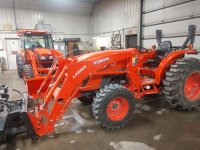Of course it raises the total c.g of the tractor, by quite a bit actually. Without the cab, the c.g is probably about at the crankshaft centerline. The cab adds a 500# mass to the base tractor weight at a height probably around waist/seat height. So the change is quite large from a mass a foot or more above the cabless tractor's location.
Plus, the cab adds quite a bit of roll inertia to the tractor, so the roll frequency is lower, presuming the same tire pressures are used. The rear tire vertical spring rates determine the roll spring rate.
So, raise the rear tire pressures to stiffen the roll to reduce that quezzy feeling. But, the C.G. is still higher, so stability is reduced. Widen the rear track (move wheels outward) to reduce the chance of a rollover on a sidehill.
You can measure the static rollover point several ways. Tilting table for 1 and some scales under each wheel as a second option. Pull it from the roll bar hoop with a winch and measure the scale load changes and the amount of roll. From this, you can make a plot and predict what the rollover angle would be [where the outside scale weights would be zero.]. That doesn't take into account any dynamic inputs (throttle, brake, driver position, and steering changes that will occur as a rollover develops, but you said you just wanted to compare 1 tractor with another.

